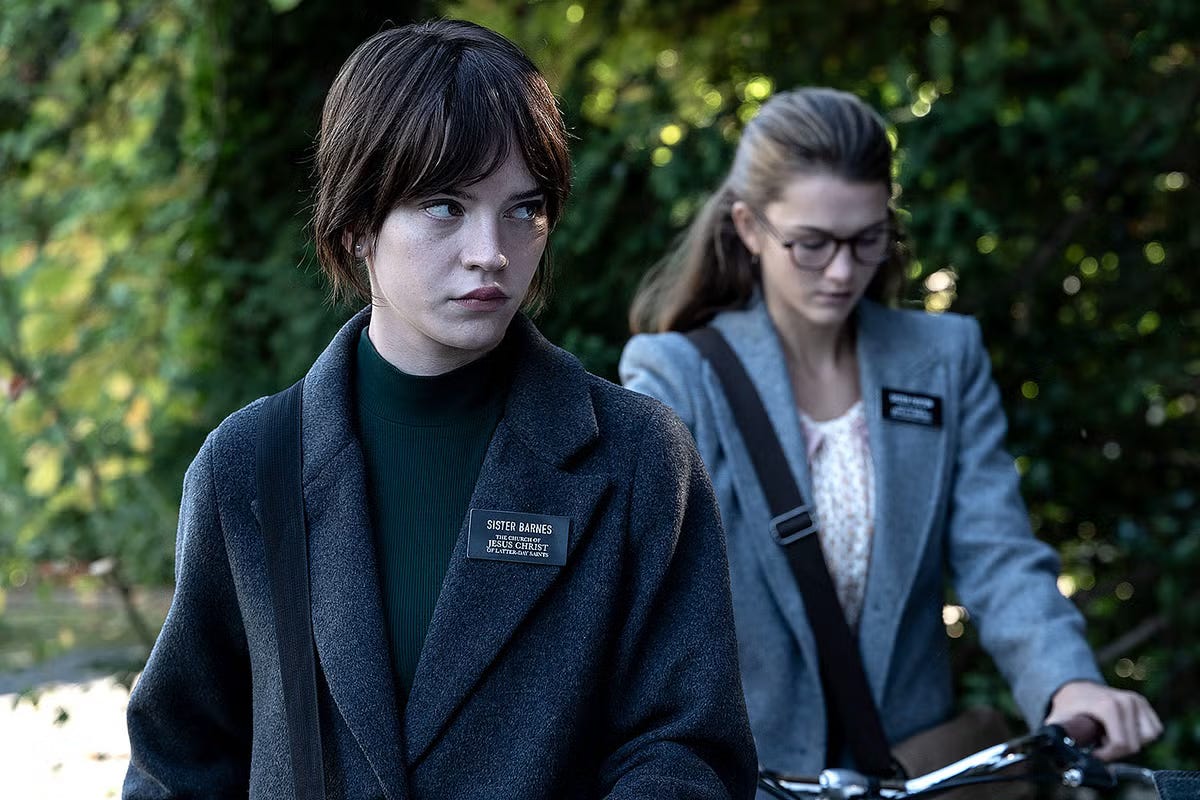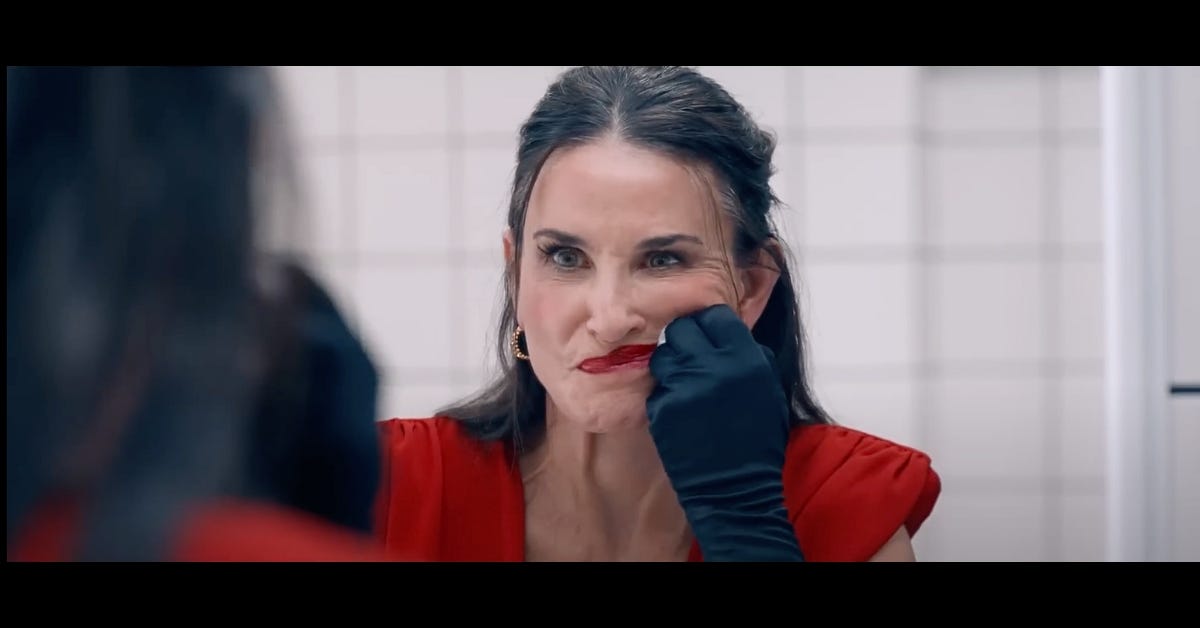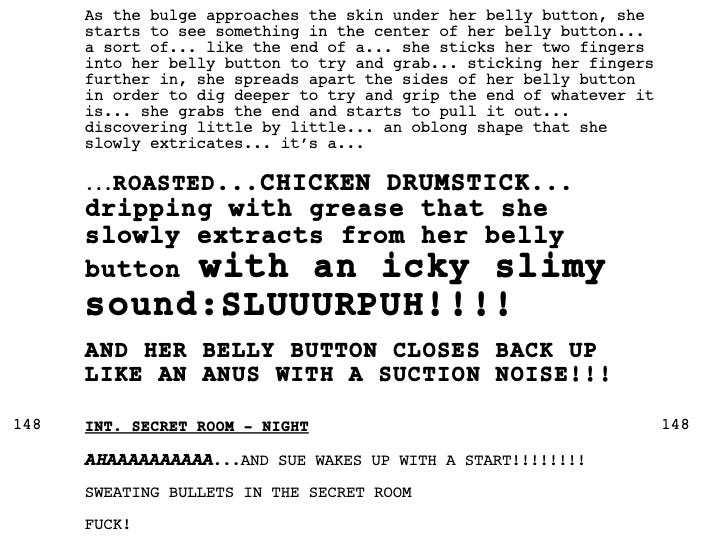When Oscar nominations were announced this year, the industry was excited that a major release in horror, a genre that typically goes underrepresented at awards shows, was nominated in so many categories.
The Substance has been nominated for FIVE Oscars, including Best Picture, Best Director (Coralie Fargeat), Best Original Screenplay (also Fargeat), Best Lead Actress (Demi Moore) and Best Makeup and Hairstyling. In nearly a century of the Oscars, only eight horror movies have netted a Best Picture nomination.
In my last post, I discussed the difference between Blueprint Screenplays vs Literary Screenplays, showing some snippets of Anora, Nickel Boys, and Conclave.
I’m here to tell you that horror screenplays are quickly becoming some of the most fun scripts to read.
Heretic, written by Scott Beck & Bryan Woods
Heretic was my favorite horror movie of 2024, and although A24 ran quite the FYC campaign, it didn’t get nearly as much awards love as it should have. I adored the writing for this film, but was even more surprised when I opened up the script and saw the unconventional styling and use of visual aides throughout.
Now I don’t know if the script I read was just the A24 awards version, prepared after the movie had already been released, but if this is the version that Beck & Woods sent around town, bravo to them for taking the risk.
Heretic follows two Mormon missionaries — Sister Barnes (Sophie Thatcher) and Sister Paxton (Chloe East) — who are lured into the home of a seemingly nice Englishman, Mr. Reed (Hugh Grant).
He lights a candle and sets out two glasses are Coke for them. They are told that Mr. Reed’s wife is baking a blueberry pie in the next room, and she’ll be out shortly. Mr. Reed then begins interrogating Barnes and Paxton on theology and doctrine, making the girls increasingly uncomfortable.
Sister Barnes and Paxton wonder where is Mrs. Reed, and why hasn’t she appeared yet?
Mr. Reed disappears from the living room to ostensibly go fetch his wife, and it’s here that we get our first reveal that something is not quite right.
Here’s how it’s shown in the script:
I GASPED when I saw the image in the script — the use of pictures in a screenplay is HIGHLY unconventional, but the shock factor of seeing it visually represented before my eyes was all the greater as a reader.
Later, the script includes the art and iconography that would appear in the movie during one of Mr. Reed’s many rants on religion:
Again, I’m not sure if this was always in there, or if this was something that was added in for the awards circuit, but either way, it’s very helpful.
There’s a brief moment when Elder Kennedy comes looking for the two missionaries and knocks on Mr. Reed’s door. For a moment, the girls think they might be saved. They pound on the door, but they’re trapped in a basement room and Elder Kennedy can’t hear them. After being appeased by Mr. Reed, he walks away.
Here’s how that moment was represented on the page:
This level of stylization is not common in a screenplay, but it makes it so much more thrilling to move through and emphasizes the HORROR of it all.
I highly recommend checking out the Heretic script, both as a literary document, and just as a rollicking fun entertaining read.
The Substance, written by Coralie Fargeat
The Substance is a shocking and incredible directorial effort. From a writing standpoint, there’s a lot to be desired, but Coralie Fargeat’s willingness to push the boundaries of body horror more than make up for it.
The Substance follows an aging actress and fitness instructor, Elisabeth Sparkle (Demi Moore), who feels herself being tossed aside by a misogynistic and cruel industry. In an effort to stay young and relevant, she imbibes THE SUBSTANCE, a mysterious drug that allows her to produce a beautiful, nubile version of herself, Sue (Margaret Qualley). The Substance, however, is quickly abused, leading to horrifying consequences.
In reading Fargeat’s script, there’s something a little stilted about the writing, perhaps because of the filmmaker’s French background. For example, here’s our introduction of Harvey, the sleazy agent who reps Elisabeth:
I think the last time I encountered the adjective “logorrheic” (extreme loquacity) must have been when I was studying for the SAT. Strange word choices like “logorrheic” are peppered throughout the script.
Fargeat doesn’t leave much up to subtext — in fact, we’re hit over the head with a sledgehammer in terms of messaging. Another minor critique I have after reading the script is that a lot of scenes end with a character trying to find a way to dash off or leave as quickly as possible (see: Harvey, Fred, the male nurse).
Nevertheless, I still found The Substance to be a fast-paced read. It’s clear the writer has a VISION for how things will be depicted and she shows us very clearly on the page. She even shows us how the Food matrices will look:
A lot of noise has been made about how Fargeat filmed some of Qualley’s hyper-sexualized fitness scenes — did it serve its purpose of showing us how much we were bought in to fetishizing the young and the beautiful? Or was it too male gaze-y and exploitative, defeating the whole point? I was interested to see how Fargeat envisioned those scenes and, well, she ended up explicitly tell us just how much ass would be shown:
What I enjoyed most about the writing however, was the use of onomatopoeia to build tension for the reader. There’s a great deal of HISSSSS, BOOM BOOMs, and any number of high-pitched whining, ringing, and BAM BAMs to make us feel the sounds of the film on the page. Take, for example, the following sequence when Sue is realizing that she needs to switch, or else:
All of those CRRRRiiiii and Plip plip plip not only break up the read for the audience, but also give a great sense of sound. Perhaps the page of the script that has drawn the most Internet buzz comes from a sickening dream sequence later in the movie:
I’ve seen people making fun of this particular page — or scratching their heads going “wtf am I reading?” — but I think all of this is quite effective. As a person who has to read a lot of scripts over the course of the year, anything that breaks up the page or builds the tension in a way that feels constructive and not tonally confused is a win.
My favorite scene of the whole movie, however, required absolutely no dialogue or crazy prosthetics. It’s the scene where Elisabeth is getting ready for a night out with Fred, an old high school friend. But each time she gets ready to leave the apartment, self-loathing rears its ugly head and stops her. It’s a devastating and tragic scene, especially when you consider how beautiful Elisabeth is, regardless of her age.
That scene wraps up in the following way on the page:
I love the interiority Fargeat gives us — “a dour, accusatory look in her eyes … Disgusting.” I love her smallness juxtaposed with the CRUSHING VERTICALITY of the palm tree.
Overall, it feels like horror scripts get to have more fun on the page, not just in terms of content, but also in terms of stylization. Of the two scripts I showed you, which movie’s writing did you prefer more?
Any other horror movies that you particularly loved from last year? Or any other horror movie scripts you were enamored by? Let me know in the comments below!
















That blueberry candle reveal…chills